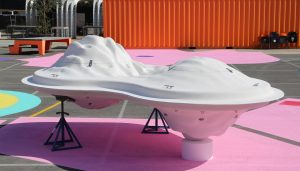Buoyant Ecologies

Buoyant Ecologies is a research partnership with the Architectural Ecologies Lab of California College of the Arts, Kreysler & Associates, and the Benthic Lab at Moss Landing Marine Laboratories. Our primary emphasis is the design and construction of floating neighborhoods in the Maldives and floating breakwaters worldwide, focusing on the use of fiberglass reinforced plastics (FRPs) for a wide range of floating structures. Our role is to optimize the marine ecosystem value of the undersides and tops of floating neighborhoods and breakwaters, and floating structures like barges and other relatively sessile vessels, docking facilities, buoys and moorings, and floating facilities for energy and so on. Marine communities can be developed to optimize desirable ecological conditions such as complex food webs to attract large predators, aquaculture ecosystems (oysters to algae), and floating breakwater habitats for attenuating coastal erosion.
Using mangrove roots as a natural model, the group designed a unique floating breakwater. The mangrove roots form an underwater forest that can attenuate water currents like a sponge, therefore we call it a mangrove root – sponge. The group also designed and constructed the Float Lab – a roughly 15' x 10' x 5' pilot-scale experimental platform that permits realistic, large-scale tests of the best designs to reduce wave and other currents to reduce coastal erosion. This scale of experiments is rare in ecology, where we usually get to do the prototype (lab bench) or small-scale experiments, and often then move directly to a very few full-scale projects, like an ecosystem restoration. The Float Lab is a unique resource for pilot scale experiments, starting with a series to develop best alternatives for using ecological solutions in marine and estuarine erosion control, including native marsh plants, coconut wattles, eelgrass beds, giant kelp and other forests of macroalgae, and floating breakwater habitats like the mangrove root – sponge and Bucky’s Wall (a patented design by Buckminster Fuller). The mangrove root – sponge is a habitat for a rich fauna of marine invertebrates and algae (where there is enough light) that attach to hard substrates and others that nestle into these complex fouling communities, as well as fish that feed on them. The future of erosion control is light, strong, and relatively inert materials like FRPs that can be moved and reused as sea level rises, combined with marine plants, coconut wattles, and concrete (also optimized for habitat value).

